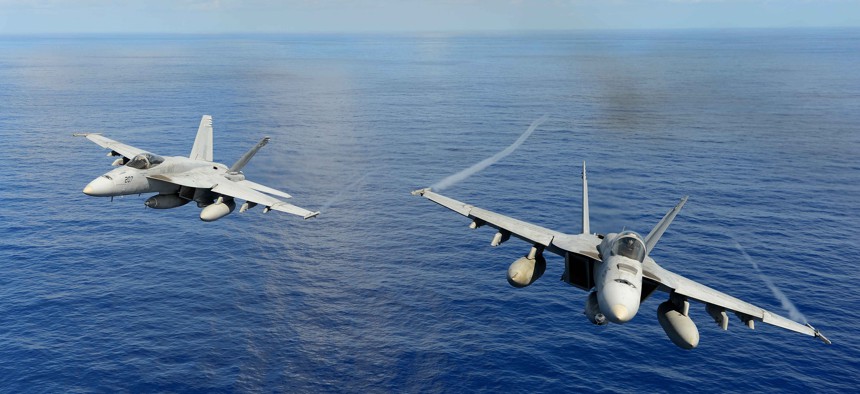
Two U.S. Navy F/A-18E Super Hornet participate in an air power demonstration in the Pacific Ocean on April 24, 2013. Mass Communication Specialist Seaman Apprentice Ignacio D. Perez
Boeing May Lose Canada’s Super Hornet Order, Yet Jet’s Outlook is Bright
The past year has brought a trade dispute with Ottawa, a big deal with the U.S. Navy, and improved prospects elsewhere.
If Canada scraps its planned $5.2 billion purchase of new F/A-18E/F Super Hornets and buys used Australian fighter jets instead, it will be a blow to Boeing and the Trump administration. Yet the outlook for the American-made warplane has brightened this year.
Citing three sources “familiar with the matter,” Reuters reported Tuesday that the Royal Canadian Air Force would buy earlier-generation F/A-18 Hornets from Australia, which is shedding them to move up to the newer model.
The move deepens the rift between the Canadian government and Boeing. The two have been locked in a nasty trade dispute over Canada’s Bombardier C Series passenger jetliner, which Boeing and the U.S. government say was improperly subsidized by Ottawa.
“Regarding Canada or any other customer, we’re here to support them,” said Leanne Caret, the CEO of Boeing Defense, Space and Security, asked about the potential Super Hornet sale on Saturday at the Reagan National Defense Forum in California. “We have a long history and we are proud to have a partnership with the government of Canada and we look forward to supporting them in whatever decisions they make.”
A Boeing defense spokesman declined to comment on the Reuters report because the Canadian government has made no announcement about the potential sale.
In April, Boeing sued Bombardier, claiming that it was dumping its new jetliner into the U.S. market at “absurdly low prices.” In September, the U.S. Commerce Department recommended a 220 percent tariff on C Series airliners sold to U.S. air carriers. In October, Commerce’s International Trade Administration recommended an additional 80 percent tariff. A final ruling on the tariffs by the International Trade Commission is expected in February.
In June, Caret told Defense One that it was “a Boeing company decision” to challenge Bombardier. “We have been very thoughtful and pragmatic as we approached this situation,” she said, noting the company’s nearly century-long sales record with Canada.
“We view them as a key partner for us,” she said. “We look forward to continuing the dialog and continuing to demonstrate the capability that the Supers provide and why that is the right choice for them for their interim solution.”
From Boeing’s standpoint, losing an order for 18 Super Hornets is a small price to pay for protecting its far more lucrative sales of airliners to U.S. airlines. If the tariffs are put in place, it could prevent Bombardier’s C Series from biting into the Boeing 737’s share of the U.S. market. In the first three quarters of 2017, Boeing delivered 381 new 737s to U.S. and international air carriers.
One year ago, things were looking up for the Super Hornet in Canada. Justin Trudeau’s government decided to scrap immediate plans to buy the expensive F-35 Joint Strike Fighter. The Royal Canadian Air Force, which already flies older F/A-18 Hornets, decided to buy a relatively small number of Super Hornets — cheaper than the F-35 — while it figured out a long-term replacement plan.
But even if Canada bows out of a Super Hornet deal, the jet’s overall sales outlook has improved this year. After running low on orders in late 2016, Boeing found a customer for a newer, more advanced version of the Super Hornet: the U.S. Navy.
The Navy is planning to buy 80 of the jets in coming years to meet a shortfall in aircraft carrier-based warplanes, and that may just be a start. Boeing believes the Navy needs a total of 150 jets to meet a shortfall, according to Dan Gillian, Boeing’s F/A-18 and EA-18G program manager.
Boeing also expecting orders to extend the planned service life of about 600 existing Navy Super Hornets from 6,000 to 9,000 hours. The work will also update the cockpit and its networking capabilities, and install new fuel tanks to extend the plane’s range. Each plane’s upgrade costs about $5 million, Gillian said.
“It has quickly gone from PowerPoint and paper to real engineering that is going to lead to real flying airplanes next year,” he said in an interview last week.
Further, the firm expects to finalize a 28-plane deal with Kuwait “very soon,” Gillian said, and sees potential for Super Hornet sales in Finland, Switzerland, India, and Germany.
“It seems like there is a lot going on internationally right now,” he said.
Boeing builds about two Super Hornets per month at its St. Louis plant. At the current rate, the production line will remain hot though the mid-2020s, Gillian said. If those additional orders come through, the company could make planes there until around 2030.




